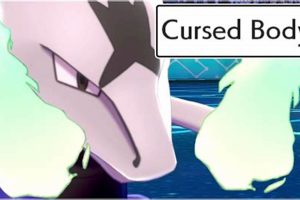Dragon Rage is a non-Normal-type move in the Pokmon franchise that always inflicts a fixed 40 points of damage, regardless of type matchups or the user’s attack stat. This contrasts with most damaging moves, where effectiveness varies based on Pokmon types and stat calculations. An example of its use is when a player’s low-level Pokmon utilizes the move against a significantly higher-level opponent, guaranteeing a fixed amount of damage that might otherwise be difficult to achieve.
Its significance lies in providing a consistent damage output, especially useful in early stages of gameplay or against opponents with high defense stats. Historically, its consistent damage made it a reliable option in early Pokmon games, before more complex strategies and move sets became readily available. This fixed damage mechanic offered a tactical advantage, circumventing typical type disadvantages or stat deficiencies.
The remainder of this article will delve into the move’s specific applications, strategic advantages and disadvantages, its prevalence across different generations of Pokmon games, and a comparative analysis against more conventional attacking moves. Details on Pokmon that learn the move and strategies involving its use will be provided.
Strategic Application and Considerations
This section outlines several strategic considerations for leveraging the consistent damage output, offering practical advice for gameplay scenarios.
Tip 1: Early Game Advantage: In the initial phases of the game, prioritize teaching the move to a Pokmon early on. Its guaranteed damage allows for efficient training against opponents with higher levels or defense stats than would be typically manageable.
Tip 2: Gym Leader Exploitation: Research the type advantages and disadvantages of upcoming Gym Leaders. When facing a Gym Leader with a Pokmon resistant to your primary attacks, the consistent damage can provide a crucial advantage, softening the opponent for your other Pokmon.
Tip 3: Wild Encounter Utility: When encountering wild Pokmon with high defense, this move can reliably weaken them for easier capture. This is particularly helpful when attempting to catch rare or powerful Pokmon early in the game.
Tip 4: Status Condition Synergy: Combine its use with status conditions like paralysis or poison. The fixed damage, combined with gradual health depletion from poison or reduced speed from paralysis, can create a potent combination for defeating opponents.
Tip 5: Strategic Switching: Employ strategic switching to maximize its effectiveness. Weaken a tough opponent with a user of this move, then switch to a more powerful Pokmon to finish the battle once the opponent’s health is sufficiently reduced.
Tip 6: Team Composition: When building a team, consider including a Pokmon specifically to utilize this move in challenging battles, especially early in the game. This dedicated role can provide a consistent solution to difficult opponents.
Tip 7: Move Set Diversity: Supplement the move with other moves that inflict status conditions or provide type coverage. This prevents the user from being completely reliant on a single fixed-damage strategy.
These strategies capitalize on the move’s reliable damage output, providing tactical advantages in various gameplay situations. Understanding and implementing these tips will optimize its use and contribute to a more successful gameplay experience.
The subsequent sections will explore specific Pokmon that learn this move, followed by a comparison against other damaging moves in the game, highlighting the strengths and weaknesses of each.
1. Fixed damage output
The fixed damage output characteristic of the move is a defining trait influencing its strategic utility within the Pokmon battling system. This mechanic differentiates it from most damage-dealing moves, which calculate damage based on complex formulas involving the user’s and target’s stats, move power, and type matchups. The unchanging damage has specific implications for tactical gameplay.
- Early-Game Power Spike
The move provides a significant advantage in the initial stages of gameplay. As levels are low and stats have not yet been fully developed, the fixed damage bypasses the need for extensive training or specific type advantages. For example, a player facing a Rock-type Pokmon resistant to Normal-type attacks could effectively use the move to inflict a flat 40 HP damage, regardless of the type disadvantage. This allows for progress through early game areas that might otherwise be challenging.
- Defense Negation
The move circumvents the impact of an opponent’s high defense stat. Many strategies revolve around increasing a Pokmon’s Defense or Special Defense to reduce incoming damage. The consistent damage disregards these stat increases, providing a reliable source of damage against heavily defensive Pokmon. This can be especially useful when facing stalling strategies that rely on slowly depleting the player’s health while minimizing damage taken.
- Predictability and Planning
The unchanging damage allows for predictable damage output. Players can precisely calculate how many times the move needs to be used to defeat an opponent, streamlining battle strategies. This predictability allows for efficient use of healing items or strategic switching of Pokmon, optimizing resource management during battles.
- Limited Late-Game Scalability
While effective in early stages, the move’s fixed damage becomes less impactful as Pokmon levels increase and other moves become available. At higher levels, the flat 40 HP damage becomes comparatively negligible against Pokmon with hundreds of HP. This limits its viability in later stages of the game, where damage is often dependent on type advantages and stat matchups.
These facets illustrate how the fixed damage output shapes strategic applications. Its consistency provides tactical advantages in early stages, negating defense and offering predictable damage, but its limited scalability necessitates transitioning to more potent, scalable moves as gameplay progresses. Thus, the role of such moves is best suited to the earlier stages of the game.
2. Early game utility
The early game utility of the move within the Pokmon franchise arises from its unique damage mechanic relative to other moves available at the beginning of a player’s journey. Its fixed damage output provides a strategic advantage when battling opponents with higher levels or defensive capabilities, offering a reliable source of damage.
- Overcoming Level Disparities
During the early stages, a player’s Pokmon often have lower levels compared to encountered wild Pokmon or rival trainers. The consistent damage output enables players to inflict meaningful damage regardless of level discrepancies. For example, when facing a level 10 opponent with a level 5 Pokmon, the move can inflict a predictable 40 HP damage, whereas a standard attack may be significantly reduced due to the level difference.
- Bypassing Defensive Stats
Certain early-game Pokmon possess naturally high defense stats, making them difficult to defeat with conventional attacks. The fixed damage output bypasses these defensive stats, offering a reliable way to weaken these opponents. A Stone-type Pokmon, known for high defense, becomes less of an obstacle, facilitating smoother progress through the game.
- Resource Management Efficiency
Consistently inflicting damage improves the efficiency of item usage and reduces the need for constant healing. Players can accurately estimate the number of attacks required to defeat an opponent, minimizing the reliance on potions or other recovery items. This resource management is particularly valuable in early game, where items are scarce and expensive.
- Facilitating Early Captures
Weakening wild Pokmon for capture is a crucial early game activity. The move enables controlled damage output, making it easier to bring a Pokmon’s health down to a capture-friendly level without risking a knockout. This is especially helpful when encountering rare or desirable Pokmon early in the game, increasing the chances of successful capture.
These factors collectively contribute to the move’s strategic significance in the early stages of a Pokmon game. The move’s reliable damage output enables players to overcome level disparities, bypass defensive stats, manage resources effectively, and facilitate easier capture of wild Pokmon, thus providing a tactical advantage that helps players to smoothly progress in the game.
3. Type indifference
The move’s most distinctive trait is its type indifference. Unlike most damage-dealing moves in the Pokmon battle system, the damage inflicted remains constant irrespective of the target Pokmon’s type. This characteristic provides a significant strategic advantage in scenarios where type matchups would normally dictate a lower damage output. The lack of type-based damage reduction or amplification is fundamental to its consistent utility, particularly in the early stages of the game when diverse move sets are limited. For instance, when facing a Steel-type Pokmon resistant to Normal-type moves, the move inflicts a fixed 40 HP damage, bypassing the typical resistance which would substantially reduce the damage from a Normal-type attack. This independence from the type chart makes the move a predictable and reliable option, especially against Pokmon with advantageous type matchups.
Further applications arise when confronting dual-type Pokmon. While a dual-type Pokmon might have a vulnerability to a specific element, exploiting that weakness might be impractical due to move availability or other team constraints. The type indifference ensures that the move consistently deals a flat amount of damage, irrespective of either type. This can be strategically relevant when dealing with Pokmon whose type matchups are complex or less favorable for the user’s current move pool. Additionally, this fixed damage can be combined with other strategies, like status conditions (poison, burn), to ensure that a specific amount of damage is inflicted reliably over time, regardless of the target’s defensive typing.
In summary, the connection between type indifference and this move is defined by the move’s ability to provide damage in circumstances where typical type-based calculations would significantly reduce effectiveness. This characteristic lends itself to predictable damage output, ensuring its use in situations where reliability is valued over maximum damage potential. While other moves may be capable of inflicting higher damage, this approach offers consistent damage against any target, regardless of defensive typing.
4. Move learnsets
Move learnsets are critical to understanding the utility and accessibility of specific abilities. In the case of Dragon Rage, its value is directly tied to which Pokmon can learn it. The availability of Dragon Rage within different Pokmon species’ learnsets determines its strategic importance at various stages of gameplay. A wide distribution across numerous species would make the move common and readily accessible, while a limited distribution would designate it as a more niche or specialized choice. Examining actual learnsets clarifies its practical impact. For example, if early-game Pokmon commonly learn Dragon Rage, it becomes a viable strategy for overcoming level disparities or type disadvantages. Conversely, if only late-game Pokmon can learn it, the moves primary advantage shifts to a consistent, though ultimately less powerful, damage option against specific opponents.
Further analysis requires considering the specific Pokmon that can access the move and when they gain access to it. For instance, if a typically weak Pokmon learns Dragon Rage early in its evolution line, that move might provide a significant boost in its early battles, allowing it to contribute more effectively to the team. Similarly, if a powerful Pokmon learns the move, it might be used to ensure consistent damage output against opponents that would otherwise resist its other, more potent moves. Understanding the learnsets enables players to strategically plan their team composition and move choices to capitalize on the moves fixed damage output at crucial points in the game.
In conclusion, the distribution of the move across various Pokmon and their levels is key. The interplay between move learnsets and the move dictates its tactical significance and practical application in the game. While the fixed damage may be useful, its ultimate impact hinges on which Pokmon species can learn the move and at what point in their development. Considering these factors helps in evaluating its potential strategic worth within a particular team composition.
5. Limited scaling
Limited scaling fundamentally defines the usage parameters of the move, differentiating it from most other offensive options available to a Pokemon. Unlike moves that derive their damage output from the user’s Attack or Special Attack stat, level, and type matchups, Dragon Rage’s fixed 40 HP damage restricts its long-term effectiveness as Pokemon stats increase.
- Reduced Late-Game Viability
As the game progresses, and opposing Pokemon’s HP pools grow exponentially, the fixed 40 damage becomes increasingly insignificant. What might be a substantial chunk of damage in the early game amounts to a negligible fraction of a high-level opponent’s health, rendering the move impractical. For instance, a level 5 Pokemon with 50 HP finds 40 damage significant, while a level 50 opponent with 300 HP would barely notice it.
- Inability to Exploit Type Advantages
Scaling damage moves benefit from type matchups, where super-effective hits can double the damage dealt. Dragon Rage, unaffected by type, cannot capitalize on these advantages. While consistency is valuable early on, the inability to exploit weaknesses limits its potential as more diverse and powerful moves become accessible.
- Stat Boosting Ineffectiveness
Moves with variable damage benefit from stat-boosting moves like Swords Dance or Nasty Plot, which increase Attack or Special Attack respectively. Dragon Rage, with its fixed output, gains nothing from these stat boosts, further limiting its strategic application as the game progresses and these abilities become more prevalent.
- Limited Competitive Application
The competitive Pokemon scene heavily emphasizes optimized damage output and type coverage. The moves’ non-scaling nature makes it generally unviable in competitive battles, where maximizing damage and exploiting vulnerabilities are paramount. More scalable moves are chosen for optimal performance, leaving Dragon Rage as a curiosity at best.
Consequently, the limited scaling of the move confines its practicality to the initial hours of gameplay or highly specific, niche strategies. While its consistent damage can provide an advantage early on, players invariably transition to more scalable and adaptable moves as their Pokemon grow stronger, underscoring its inherent limitations in the broader context of the game.
6. Tactical advantages
The tactical advantages derived from Dragon Rage within the Pokmon battle system stem from its consistent, fixed damage output, offering specific benefits in certain scenarios, particularly during the early to mid-game stages or against opponents with unique characteristics. These advantages, however, need to be assessed in relation to the move’s limitations, such as its lack of scaling and type indifference.
- Early-Game Leveling and Progression
During the early stages of the game, when a Pokmon’s move pool is limited and stat values are relatively low, Dragon Rage allows players to reliably inflict damage on higher-level opponents. For example, a newly acquired Pokmon facing a rival trainer’s more experienced creature can use Dragon Rage to inflict a predictable 40 damage, contributing meaningfully to the battle outcome when standard attacks might prove ineffective. This facilitates smoother progression through the initial areas of the game.
- Defense and Stat Buff Negation
The fixed damage of Dragon Rage bypasses the defensive stats of opponents, as well as any stat boosts they may have accumulated. This is advantageous when battling Pokmon that employ strategies centered on raising their Defense or Special Defense, where other attacks would be mitigated. The move ensures a consistent reduction in the opponent’s health, irrespective of their defensive capabilities.
- Guaranteed Damage in Risky Situations
In situations where missing an attack or facing a status condition that reduces damage output is a concern, Dragon Rage offers a guaranteed amount of damage. This reliability can be critical when facing opponents with high evasion rates or status-inducing moves. The predictability of the damage allows for strategic planning, such as calculating the precise number of attacks needed to defeat an opponent before switching to a different Pokmon.
- Exploiting Specific Opponent Weaknesses
The consistent damage of Dragon Rage can serve as a foundation for exploiting specific weaknesses in an opponent’s strategy. For example, if an opponent relies on healing frequently, the fixed damage output combined with status conditions like poison or burn creates a persistent threat that gradually wears down their health, limiting their ability to stall the battle. Combining Dragon Rage with these tactics requires careful timing and knowledge of the opponent’s capabilities.
While Dragon Rage provides these tactical advantages, it is important to acknowledge that its lack of scaling and type indifference limit its long-term utility. As Pokmon levels increase and more powerful moves become available, the fixed damage becomes less impactful. Therefore, Dragon Rage is most effective when used strategically during specific early-game scenarios or against opponents with unique characteristics that negate the limitations of the fixed damage mechanic. This understanding is crucial for leveraging the tactical advantages it provides while mitigating its drawbacks within the broader context of the game.
7. Competitive viability
The competitive viability of Dragon Rage in the Pokmon battling scene is fundamentally limited by its fixed damage output. This move inflicts a constant 40 HP damage, irrespective of type matchups, stat boosts, or opponent defenses. In a competitive environment where strategic depth and optimized damage output are paramount, the move’s lack of scaling renders it largely ineffective. Competitors seek to maximize damage potential, exploit type weaknesses, and capitalize on stat advantages, all of which Dragon Rage cannot facilitate due to its unvarying damage. For instance, a competitive team employing hyper offense strategies requires moves capable of swiftly knocking out opponents, whereas Dragon Rage’s consistent but low damage offers minimal impact against high-HP Pokmon.
In contrast, moves commonly used in competitive battles, such as Earthquake or Moonblast, scale damage based on the user’s Attack or Special Attack stat and the target’s type. These moves, when utilized effectively, can inflict substantial damage, often leading to one-hit knockouts or significant health reductions. Furthermore, competitive battling often involves complex team compositions and intricate strategies, such as entry hazard setting or status condition infliction, where moves must serve multiple purposes. Dragon Rage, limited to dealing a fixed amount of damage, lacks the versatility required for these advanced tactical approaches. An example illustrating this point is a team employing Stealth Rock to inflict entry damage on switch-ins, followed by powerful, type-effective attacks to secure knockouts. Dragon Rage cannot contribute to such strategies effectively, as it does not provide enough immediate threat.
Ultimately, the limited competitive viability of Dragon Rage stems from its inherent design. While it may offer some tactical advantage in early-game scenarios within the main Pokmon games, the competitive scene demands moves that can scale and adapt to a diverse range of opponents and strategies. As such, Dragon Rage remains a niche choice, rarely, if ever, appearing in competitive team compositions. The constraints of its fixed damage render it obsolete in an environment where optimized damage output and strategic flexibility are essential for success.
Frequently Asked Questions About Dragon Rage
This section addresses common inquiries regarding the Dragon Rage move in the Pokmon series, clarifying its mechanics and strategic applications.
Question 1: What precisely is the damage calculation for Dragon Rage?
The move inflicts a fixed 40 HP damage on the target Pokmon, regardless of type matchups, the user’s Attack or Special Attack stats, or the target’s Defense or Special Defense stats. This contrasts with most damaging moves, where damage is calculated using a complex formula involving multiple factors.
Question 2: How does type effectiveness influence the damage dealt by Dragon Rage?
Type effectiveness has no impact on the damage inflicted. The move inflicts 40 HP damage whether the target Pokmon is resistant, neutral, or weak to Dragon-type moves. This differs significantly from most attacks, where type matchups can double or halve the damage dealt.
Question 3: At what point in the game does Dragon Rage lose its effectiveness?
The move becomes less effective as Pokmon levels increase and their HP pools grow. In the early game, 40 damage can be a significant portion of an opponent’s health. However, by the mid- to late-game, when Pokmon can have hundreds of HP, the fixed damage becomes comparatively negligible.
Question 4: Can stat-boosting moves enhance the damage output of Dragon Rage?
Stat-boosting moves, such as Swords Dance or Nasty Plot, do not affect the damage inflicted by Dragon Rage. These moves increase the user’s Attack or Special Attack stat, respectively, but this move’s damage is fixed and not influenced by stat modifications.
Question 5: Are there any Pokmon with abilities that can modify the damage inflicted by Dragon Rage?
Generally, no abilities directly modify the damage inflicted. Some abilities might indirectly affect the move’s usefulness by altering the battle environment or the target’s stats. However, no known ability specifically increases or decreases the fixed 40 HP damage.
Question 6: How does Dragon Rage fare in competitive Pokmon battles?
The move is rarely, if ever, used in competitive Pokmon battles. Its fixed damage output is not competitive with the scalable damage of other attacks, which can be boosted by type matchups and stat enhancements. Competitive players prioritize moves that can inflict maximum damage to achieve quick knockouts.
In summary, the move serves as a consistent early-game damage source, but its fixed nature limits its long-term viability, particularly in competitive scenarios. Understanding its mechanics is key to employing it effectively within the appropriate context.
The next section provides a comparative analysis against other damaging moves in the game, highlighting the strengths and weaknesses of each.
Conclusion
This exploration has detailed the intricacies of the Dragon Rage move within the Pokmon franchise, emphasizing its fixed damage mechanic, early-game utility, and ultimate limitations. The move’s fixed damage output sets it apart from scalable attacks, providing a consistent, albeit finite, advantage. Its type indifference and defense negation capabilities are most potent in the initial stages, offering a reliable means of inflicting damage irrespective of opponent characteristics. However, the lack of scaling renders it strategically obsolete as Pokmon levels increase and move sets diversify. Competitive viability remains negligible due to the demand for optimized, type-effective damage.
The analysis presented underscores the importance of understanding move mechanics within the broader context of Pokmon battling. While Dragon Rage may hold nostalgic appeal or serve as a stepping stone for novice players, its true value lies in illustrating the evolution of strategic decision-making as gameplay progresses. Further exploration of niche strategies and underutilized moves can yield untapped potential, fostering a deeper appreciation for the intricacies of the Pokmon battle system. The application of this knowledge enhances strategic acumen, facilitating more informed choices in team composition and move selection. Continuous exploration promises a deeper engagement with the tactical nuances of Pokmon battles.







